|
Atoms Atoflex I |
Manufactured or assembled in France from 1948 to 1951.
Index of rarity in France: Infrequent (among non-specialized garage sales)
Inventory number: 501
See the complete technical specifications
Chronology of cameras Atoms
Modern TLRs all trace their lineage back to the Rolleiflex, introduced in 1929 by Franke & Heidecke, specialists in stereoscopic camera.
Apart from Cornu, with his rather unorthodox Ontoflex, no French manufacturer showed interest before the war in '39; German supremacy was prevailing.
After the Liberation, there was an explosion: Celtaflex, Atoflex, Semflex, Rex Reflex, Royflex, Bioflex...
The Atoflex is a true twin-lens reflex, and Atoms no longer hesitates to associate the name of the camera with that of the company.
The coupling of focusing, achieved through front lens rotation for capturing and helicoid for viewing, might seem suboptimal but simplifies the mechanical design of the camera itself. It also allows for a slightly shorter focal length for viewing, preventing cropping of the image edges on the ground glass.
For aesthetics, a housing surrounding the lenses gives an appearance reminiscent of the Rolleiflex, although it only displays a simple depth of field scale. The cover is hollowed out, and a diverging lens enables eye-level viewing.
| Years | Lens | Shutter | |||
| Aiglon |  |
1948-51 | Angénieux 4.5 | Atos-1 | Uncoupled lens |
| Aiglon Reflex |  |
1950-51 | Angénieux 4.5 or Berthiot 4,5 |
Atos-1 ou Atos-2 | Coupled Lens |
| Atoflex I | 1948-51 | Angénieux 4.5 | Atos-1 | Coupled lens and Eye-level viewfinder | |
| Atoflex II |  |
1951 | Angénieux 4.5 | Atos-2 | Coupled lens and Eye-level viewfinder |
| Atoflex III |  |
1951 | Angénieux 3.5 | Atos-2 | Coupled lens and Eye-level viewfinder |
This variant features an Atos-I shutter with speeds ranging from 1/10 to 1/150. The viewing lens is an Angénieux (type Z5) 3.3/70, and the taking lens is an Angénieux (type U1) 4.5/75, numbered 145,133 (number sequence: 116,707 – 170,652).
In 1950, the Atoflex with a f/4.5 lens was priced at 23,790 francs (Photo-Plait), while the same model with a f/3.5 lens was priced at 27,190 francs.


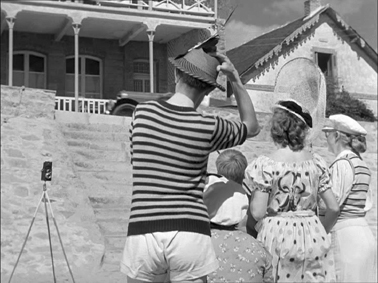
History by Arnaud Saudax
When Paul Royet, under the direction of Jean Cros, began the construction of Reyna-Cross cameras, he quickly realized that the weak link for industrialization in Saint-Étienne would be the production of shutters. (For mechanics, there was Manufrance and for optics, there was already a well-established company, Tourret & Narrat, and a newcomer, Pierre Angénieux...)
Unable to convince the SEMM executives, he decided to take on this project alone in his Micromécanic repair workshop. For tooling, he turned to Saprolip in Valence, a subsidiary of Lip, where he met former students from the watchmaking schools in Cluses and Besançon. During the Occupation, bartering and resourcefulness could foster sincere friendships...
Through a representative, he learned of an individual in Nice who was building photo enlargers under the Laborum brand, and his name was Mr. René Carrouée. He invited him to Saint-Étienne and introduced him to Mr. Grange, the distributor of Reyna-Cross cameras. Rex would market it under the Ener brand, which was an anagram of René.
When Gitzo suspended production, Paul Royet was able to sell his Micromécanic shutter production to SEMM, for which he had filed a patent, and then transferred the license and equipment in exchange for 50% of SEMM's shares. (Which didn't really please Jean Cros.)
After the war, he dreamed of a photographic industry in Saint-Étienne and managed to lure a number of technicians and engineers from Saprolip to form a team with proven skills to design and produce a high-performance shutter and a high-end bi-objective lens.
Frustrated by the prerogatives he was losing, a close collaborator of Paul Royet denounced him for theft and trafficking during the Occupation... The atmosphere at SEMM became execrable, especially since ongoing trials made its future uncertain.
It was then that Mr. Grange suggested taking over SEMM's activities in Nice, at Carroué's company, and a company project was developed, after which SEMM's draftsman, Mr. Michard, was sent to Nice with the blueprints for the future shutter and 6 x 6 bi-objective lens. He was later joined by Messrs. Bugeaud, Guigue, Coisy and Petit, all former Saprolip employees. Paul Royet, realizing that he would lose his leadership role, then gave up the adventure...
Thus was born the Association of Technicians in Optics and Scientific Mechanics.
Grange handled the commercial side, and Angénieux, who retained his independence, took care of the optics side.
René Carrouée filed a number of patents:
 |
| FR-909.638-A Requested on March 10, 1945, obtained on January 4, 1946, and published on May 14, 1946. Ground glass focusing screen for small and medium format cameras. Which can be found in catalogs under the Ener brand, in Contax, Leica, and Foca mounts. |
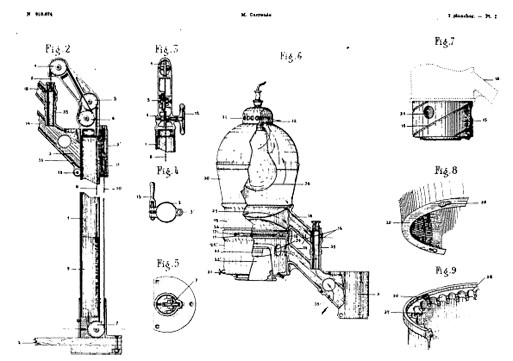 |
FR-910,674-A |
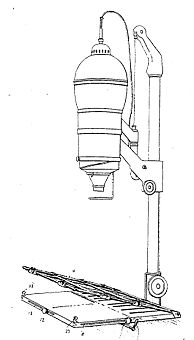 |
| FR-943.501-A Requested on March 21, 1947, obtained on October 4, 1948, and published on March 10, 1949. chassis-feeder for photographic enlargers |
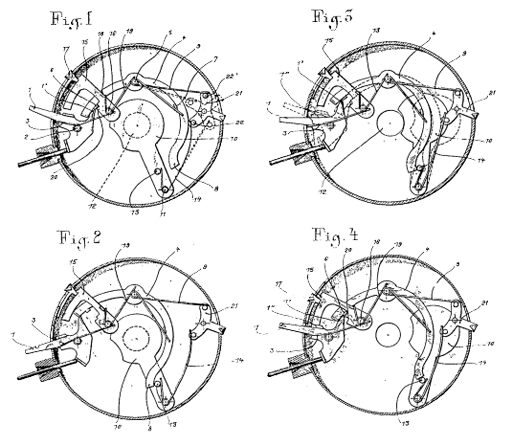 |
FR-975,739-A |
Georges Bugeau a déposé un brevet, lui aussi à Nice :
 |
||
FR-943,539-A |
ATOMS would sell the Aiglon and Atoflex, but would focus on the production of shutters. Some were sold under the name ATOS, but most were anonymous, for larger manufacturers like Foca and Kodak. The shutter of the CalypsoPhot is also an original design by Atoms.
In 1962, Atoms provided shutters for the SEM's Challenger and Colorado (probably the shutter covered by Atoms FR-1.201.131 patent of August 6, 1958, July 6, 1959, and December 28, 1959), and in the 1970s, when the activity was almost stopped, Bernard Vial found a prototype of the Vérascope in American format and a Kinax 3D for which Atoms was asked to study the shutters...
(These pieces of information come from Paul Royer's personal archives, of which a copy was deposited at the Museum of Arts and Industry in Saint-Etienne.)
Interesting links or bibliography :
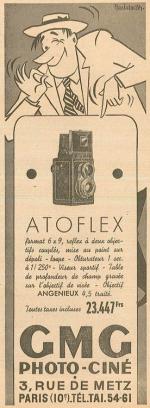 Photo Revue de 1949 |
Add a link or element of bibliography, a picture taken with this camera, a picture of box or an ads about this camera
Your photos taken with the same camera:
Cameras from Ebay France (Atoms) (Uploaded each 3 hours)







